Dec-21-19
 | | KEG: Mason v. Didier
Didier had a short unhappy career as a tournament chess player. He finished tied for last at Paris 1900, winning one and losing 15. His only victory there was against Sterling, who shared last-honors with him. He did draw two games at Paris 1900, (against Mason and Rosen), but draws were replayed at that tournament and the score was based on the replayed-game. Since Didier lost the replays at Paris 1900 against both Mason and Rosen, his final score there was 1-15. At Monte Carlo 1901, Didier lost his initial games against 12 of the other 13 competitors. His only draw was against Mason--a game not given on this site. Didier lost the replay (the game shown here). Under the rules at Monte Carlo, draws counted 1/4 of a point (with the other half-point determined in the replay). As a result, Mason gained 3/4 of a point from his games at Monte Carlo against Didier, while Didier received 1/4 of a point, leaving his final record at a miserable 1/4--12 3/4. In fairness to Didier, I felt obliged to annotate the game that gave him the 1/4 point that kept him off the complete schneid. The game itself was hardly a thing of beauty. As in all his games, Didier seemed determined to go down fighting rather than play solidly for equality. In this case, aggression--after some scary ups and down--led to a draw against one of the two opponents he had drawn with at Paris 1900. 1. e4 e5
2. f4 exf4
3. Bc4
The wild "Bishop's Gambit." Bobby Fischer surprised Larry Evans with this opening while he was en route to his 11-0 finish at the 1963-1964 US Championships. Perhaps Mason thought he would be able to blow the usually hapless Didier off the board and get a quick win. 
click for larger view3... d5
3...Qh4+ is more usual and better. 3...Nc6 is also a good line for Black. But Didier was seemingly intent on counter-attack. 4. Bxd5 Qh4+
Having played 3...d5, Didier might have considered 4...Nf6 or 4...Ne7. As was so often the case, however, Didier chose the wildest line. He was in last place with 0-5 going into this game, so perhaps he felt he had little to lose. 5. Kf1 g5?!
Again choosing the most complicated and counter-attacking line. Duduer could have tried 5...Nf6 or 5...c5 (or even 5...Nc6) had he been looking for a sound game with at least equal chances. 6. Nf3 Qh5
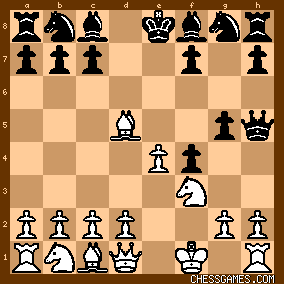
click for larger view7. h4
One of the thematic moves in this opening. A calmer alternative was 7. Nc3 7... h6
Again choosing the most unclear and aggressive line in lieu of 7...Bg7 or 7...Ne7. The text is not necessarily bad for Black, but the move is only possible if the player is ready to deal with the wild tactical complication that are sure to follow: 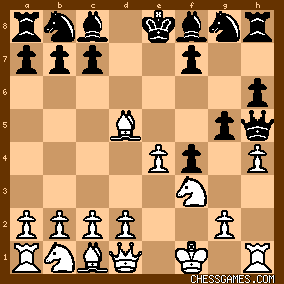
click for larger view8. Bxf7+
White can play for a more placid but approximately even game with 8. Nc3. This was obviously of no interest to Mason here. 8... QxB
Obviously not 8...KxB?? 9. Ne5+ winning the Queen. 9. Ne5 Qe6
10. Qh5+ Kd8
11. Nf7+
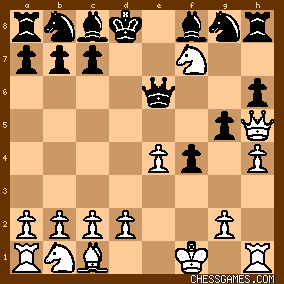
click for larger view |
|
Dec-21-19
 | | KEG: Mason v. Didier--Post II
11... Ke7?
Already a losing blunder(or what should have been a losing blunder) from Didier. It was not hard to see that this allows the Knight to check on g6. Didier should have played 11...Kd7 after which play might have continued 12. NxR Nf6 13. Qf7+ QxQ
14. NxQ Nxe4 after which White should probably seek equality by returning the exchange with 15. hxg5 Ng3+. What followed after the text was predictable
12. NxR Nf6
13. Ng6+

click for larger view13... Kf7
14. NxB+ NxQ
15. NxQ Ng3+

click for larger view16. Kg1?
Locking his Rook in the corner and giving Didier a chance to try to crawl back into the game. 16. Ke1 was correct and leaves White up the exchange after 16...KxN (this or the inferior 16...BxN is forced to stop White from winning the other Rook with Nxc7) 17. Rh2 Nxe4 18. hxg5 hxg5 19. d3. 16... BxN

click for larger view17. d4?
Mason should have hung onto his Rook with 17. Rh2, after which he would have had excellent winning chances, e.g. 17...g4 18. d4 Ne2+ 19. Kf1 g3 20. Rh1 NxB 21. d5 Bg4 22. Nc3 Nxa2 23. RxN leaving White in a messy position, but up the exchange. 17... NxR
18. KxN Nd7
19. hxg5 hxg5
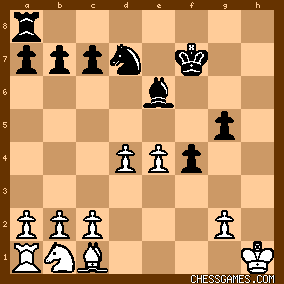
click for larger viewThe dust has cleared and Mason has reached an ending a pawn up. Give his endgame prowess (which even Lasker admired), Mason probably expected to defeat Didier with ease. But the win--if any--is hardly easy. There are Bishops of opposite colors (a theme that was to hamper Mason to the end of the game), White's center pawns could easily come under attack, and Black had attacking chances on the King-side. 20. Nc3?
A bad start toward trying to win this endgame. He should have played 20. b3 or 20. Nd2 (to be ready to hop to the King-side). 20... Nf6
21. d5
Mason could also have played 21. b3 rather than creating possible weaknesses in passed pawn phalanx. 21... Bg4
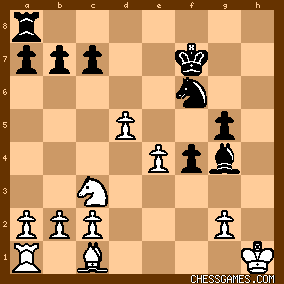
click for larger view22. Bd2
Mason should have followed up his last move with 22. e5. 22... Rd8
23. Re1 Nh5
23...c6 was the simplest way to eliminate White's threats and try to head for a draw. 24. e5
Two moves too late to hope to obtain any kind of advantage. 24... Ng3+
25. Kg1

click for larger viewMason's endgame play here had not been a thing of beauty, but he was still a pawn to the good, so Didier had to brace himself for a likely tough defensive task. But from here Didier embarked on a disjointed and unsound scheme that should have allowed Mason to wrap up the game quickly. I will discuss the coming foibles by both sides in my next post on this game. |
|
Dec-21-19
 | | fredthebear: <Hey Mr. KEG!> The game notes above were posted to the wrong game. This is Mason game 424. The correct game is Mason game 423. (Both games were against Didier, but they changed colors.) It's a simple mouse click slip, which all of us make on a regular basis because the line spacing is so narrow. Mason game 423 (Bishop's Gambit):
J Mason vs M Didier, 1901 Perhaps there is still time to cut and paste your notes to the correct game. If the DELETE option is no longer possible, contact the editors for help. (There's been some changes in that regard, so desired assistance maybe delayed.) Your clock is running! |
|
Dec-22-19
 | | KEG: <fredthe bear>Thanks for pointing this out. The Mason-Didier game (as opposed to the Didier Mason game) didn't appear in the Monte Carlo 1901 data base. Thanks for pointing this out. I will see what I can do to get my notes in the right place! |
|
Dec-22-19
 | | KEG: Mason-Didier, Post III
<fredthebear> I can't figure out how to move my notes to the correct game, so I left my notes here and suggested in my comments to the correct game for readers to look here. Apologies to all. My only excuse is that the Monte Carlo 1901 page does not include this game. Now--thanks to you--I know how to track down games not listed on a specific tournament. 25... Rh8?
The beginning of what should have been a losing plan. In light of his compensation for the lost pawn discussed above, Didier should have played 25...c6. Even 25...Rd8 would have been better. 26. Nb5
Mason could also have played 26. e6+ After the text, the position was: 
click for larger view26... Bf5?
Having played 25...Rh8, Didier had to try 26...Kg6 to have any (theoretical) chance of staying in the game. But he was transfixed with his bad plan. 27. e6+

click for larger view27... Kg6?
What was essential on his last turn was now--in light of 27. e6+--a theoretically fatal mistake. He has to be prepared to hold the fort with 27...Ke7 to have any (theoretical) chance. After 27...Ng6+, the position was:
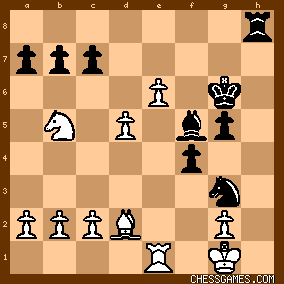
click for larger view28. e7?
Huh? Mason had a seemingly easy win now with 28. Nxc7 if then 28...Bxc2 29. e7. If 28...Ne4 29. Bc3. In any case, White's pawns are too strong for Black to survive after 28. Nxc7. Now, Didier was back in the game. 28... Rh1+
The simple 28...Kf7 was better. After the text and the coming trade of Rooks, Didier's saving line became more difficult. 29.. Kf2 RxR
30. KxR Kf7
So now we reach the minor piece ending Didier wanted: 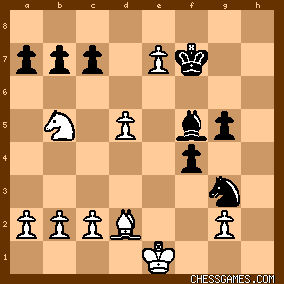
click for larger view31. Bb4 Bxc2?
Reviving Mason's winning chances. He should have simplified his task with 31...Bd7. 32. Nxc7
Better late than never.
32... Ba4

click for larger view33. d6?
After this precipitous push, the win was no longer there for Mason (though Didier managed to create a few chances for him). 33. Ne6 was Mason's only real winning chance.
33... Bc6
34. b3 Ne4
35. a4

click for larger viewMason seems to be stymied here. But the game still had a few twists and turns before Didier managed to pick up his 1/4th of a point. |
|
Dec-22-19
 | | KEG: Mason v. Didier Post IV
35... g4!
Active counter-play was the best way to secure the draw. 35...a5 would also have been good. 36. a5 a6
36...f3 immediately was probably easier.
37. Ke2

click for larger view37... f3+
Clever. It sets up a saving discovered check with the Bishop. But 37...Bd7 was simpler. 38. gxf3 gxf3+
39. Kxf3 Nxd6+
40. Kf4
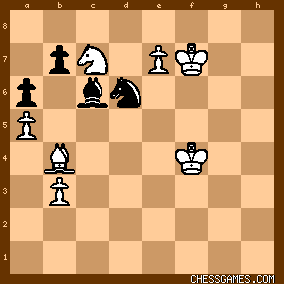
click for larger view40... Ne8
40...Kxe7?? would lose a piece to 41. Ke5.
But 40...Nc8 was simpler.
41. Na8
41. NxN looks better, but I can't find a winning strategy even with that move. 41... Ke6
42. Nb6 Nc7
Again making matters difficult for himself. He should have played 42...Nf6 43. Kg5 Nd5
44. NxN KxN

click for larger viewNow, with the power of opposite color Bishops, even Didier couldn't blow the draw, and secured his precious 1/4th of a point. 45. Kf6 Be8
1/2 -- 1/2 |
|
Dec-22-19
 | | fredthebear: There is a way to circumnavigate the system to replay your game notes on this page. Read the next move, then manually mouse click and drag the unit on the board from it's location to it's new square. When you mouse click on the unit to be moved, HOLD DOWN ON THE CLICK AS YOU DRAG the unit to it's new square. Do not release the click early. Start the game 1.e4 e5 as usual with the command arrows below the game board, but go no farther. Now, using KEG notes each and every move, click down and drag the actual unit to it's new square. So, click on the f2-pawn and drag it to 2.f4 and release it there. Then click on the Black e5-pawn and drag it one square diagonally to the f4 square. Release it on f4, resulting in a capture. Move the pieces with your cursor instead of the command arrows. Continue. Scroll down, read the notes. Scroll up to the board, click and drag the unit to it's new square, and release. I often use this drag-the-unit approach during the middle of a game replay to conduct my own analysis of alternative moves. Simply branch off; make a different move on the board instead of following the actual game score. What's more, if one player resigns, I'll play on a bit farther for a deeper look at the most likely continuance. |
|
Dec-22-19
 | | fredthebear: Didier's game page (just 28 games) is confusing. The Spanish game is there, but not the Bishop's Gambit. Furthermore, these two played a pair of games in 1900 and 1901. As KEG notes indicate, Didier was not a strong player, so his missing games might not be too concerning. |
|
Dec-23-19
 | | KEG: <fredthebear>I will try, but don't underestimate my computer illiteracy. In any case, your note has taught me that when a game is missing from a specific tournament page I can go back to the page for one or both of the players and search for the game there. In any case, thank you for your help and suggestions! Even if I falter here, it will definitely help me in the future. |
|
Jan-18-20
 | | KEG: Didier v. Mason, Post I
Turning now to the replay of the 6th round draw between Mason and Didier (and it is this latter game that appears on this site), we find Didier returning to form and blundering away another game. Mason did nothing especially commendable. He hung around on the Black side of Berlin Defense, and patiently awaited Didier's inevitable misplays. The ending that ensued after Didier blundered away the exchange might have been of some interest, but Didier found a way to ruin any drawing chances he might have had in very short order. 1. e4 e5
2. Nf3 Nc6
3. Bb5 Nf6
4. 0-0 Nxe4
5. d4 Be7
Kramnik draw a bunch of games against Kasparov in their world championship match with 5...Nd6, enabling him to wrest the title from his famous opponent. The text, which is certainly playable, goes back to Andersen and Zukertort, both of whom played it frequently. 6. Qe2
The most frequently played (and probably best) line against 5...Be7. 6... Nd6
7. BxN bxB
8. dxe5 Nb7
8...Nf5 looks better on its face, but the text was a favorite of Andersen and Zukertort, and--strange though it looks--was adopted by many others, perhaps most notably Emmanuel Lasker. The famous yet still strange-looking position after 8...Nb7 was: 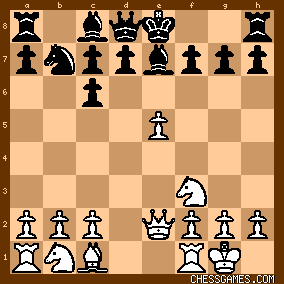
click for larger viewAwkward as Black's position looks, and though it has been much ridiculed, it has never to my knowledge been refuted. 9. Be3
"An old weak form of development. 9. Nc3 is normal." (Tournament Book). While the text is not one of the most popular lines here, and is perhaps not as good as 9. c4, 9. Re1, 9. Nc3, etc., there is nothing much wrong with this developing move. It had nothing to do with Didier's defeat here. 9... 0-0
10. Nd4
A novelty. While it looks clumsy, the text is not all that much worse (if at all) to its alternatives, and once again did not truly contribute to Didier's defeat. 10... Qe8
Preparing to keep an eye on the c6 pawn after his coming d5. I prefer 10...f6. 11. Nc3 d5
11...Bb4 and 11...f6 are other ways to try to free Black's game. 12. exd6 e.p.
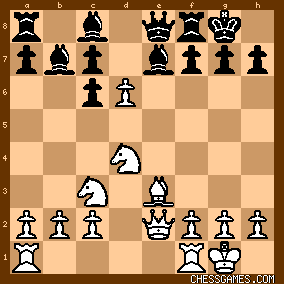
click for larger view12... Bxd6
"This gives only equality. With 12...cxd6!, Black would have a slight advantage." (Tournament Book) While I agree that 12...cxd6 (straightening out his pawns rather than burdening himself with isolated doubled pawns) was best, White surely is better even with 12...cxd6. After the anti-positional text, Black most certainly has not achieved "equality." 13. Qf3 Bd7
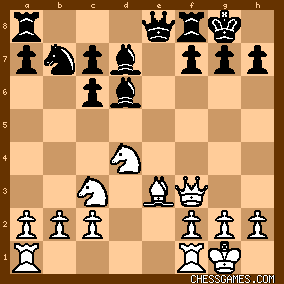
click for larger view14. Nf5
It almost looks as if Didier wanted to help Mason clean up his Queen side pawn structure with exchanges. While the text is not terrible, White should surely try to capitalize on his superior position with something like 14. Ne4 or 14. Rad1 or 14. Rfe1 or 14. Bf4. 14... Qd6
15. NxB QxN
I do not understand why Mason didn't just play 15...cxN with a reasonable position. After the text, Didier was definitely better: 
click for larger viewWhile Didier looks fine here, it took him only two moves to ruin his position. To this point, the game was uninspired. The following play, however, was simply wretched. |
|
Jan-18-20
 | | KEG: Didier v. Mason--Post II
16. Bf4
A nothing move that makes it appear that Didier was itching for more exchanges rather than making a serious effort to play to win. Better tries were 16. b3 [to block the b-file and to protect the a-pawn once the Knight moves] and 16. Rad1 [to pile up on the d-file]. The move played is not all that bad, providing White's horizons are limited. 16... Qg6
Did he have an inkling this might induce Didier to blunder? After 16...Qg6, Didier, despite his haphazard play to this point, was still OK, and--with Black's pawn structure damaged--he probably had theoretically better chances: 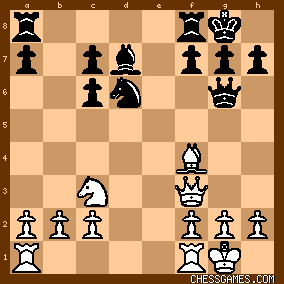
click for larger view17. Rad1?
"A blunder like this is not often seen in master tournaments." (Tournament Book). "He must play 17. BxN cxb 18. Qe4." (Tournament Book). The proposed line is certainly reasonable, but Didier had plenty of other decent options here; e.g., 17. Qd3; 17. Rac1. Instead, he made this beginner's blunder, falling into a skewer. 17... Bg4

click for larger viewGiven the busted Black Queen-side pawn structure, it is not clear that White is lost here. But now came a comedy of errors in which Didier's bad play more than compensated for Mason's sloppy chess: 18. RxN?
He would have had better chances with the simply 18. Qxc6. After the text, Mason probably did have a winning position. But not for long: 18... BxQ?
In his zeal to get to an endgame (the strongest part of his game), Mason missed what looks like a simple win with 18...cxR 19. Qxc6 Qxc2 "cxR would have been better." (Tournament Book). Indeed. After the text, the game reduced to an ending that is far from a clear win for Black: 19. RxQ fxR
20. Bxc7 Rf7
20...Bg4 was also good.
21. Bg3
21. Bd6 and 21. Be5 were both better.
21... Bd5
Black would be more clearly on top with 21...Bg4. After 21...Bd5, the position was:

click for larger view"The ending is not easy to win." (Tournament Book) I would go further and offer to bet the farm that Mason would not have come close to winning this game if the White pieces were commanded by Lasker, Rubinstein, Capablanca, or Carlsen. But Mason was not paired here with one of the above-named endgame giants. Indeed, Daffy Duck could not mess up the White situation much worse than Didier did en route to yet another loss. 22. b3
Hardly best, but not a blunder a la Didier...yet. 22... Be6

click for larger viewWhite to move and lose. A sane player with White would consider 23. h4 or 23. Rc1 or 23. Rd1. My choice, 23. Nd1, was trashed by the Tournament Book, which claimed that it would land White in trouble after 23...Rd8, but White still looks fine to me after 24. Ne3. But Didier was not thinking along any of these lines and came up with a move that was not in my mental data-base. |
|
Jan-18-20
 | | KEG: Didier v. Mason, Post III
23. Ne4?
Having fallen into one damaging skewer on move 17 which cost him the exchange, Didier now falls into another, that pretty much lands him into a lost position. 23... Bf5

click for larger viewThis looks bad for White, but Didier managed to make matters even worse for himself: 24. f3?
The only hope lay in 24. Nd6, though Black still seems to win with 24...Re7 25. c4 (25. NxB gxN leaves Black with some work to do, but the result does not appear to be in doubt) and things look grim for White. But this is all better than what happened after the text (24. f3?). 24... BxN!
The clearest winning line.
25. fxB RxR+
26. KxR Re8

click for larger view27. e5
Given that the e-pawn is doomed, Didier might have tried 27. Bf2, though that too held out no realistic hope of holding the game. 27... Kf7
27...g5 is a simpler winning line for Black, preparing his own pawn assault. 28. Ke2?
Beginning a hopeless quest to save the e-pawn that soon enough allows Mason to storm the King-side. 28... Ke6
Everything here wins for Black, but 28...g5 was fastest. 29. Kd3
Probably best to inhibit g5 for at least a while with 29. Bf4. 29... g5
29...Rd8+ was another winning line.
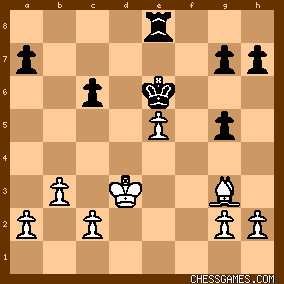
click for larger view30. Kc4?
Moving his King out of range to protect against what Mason has brewing on the King-side. 30... h5
Better to wreck havoc beginning with 30...Rd8 or 30...Rf8. But even after the text, White's chances are slim to none: 
click for larger view31. Kc5?
"?"--(Tournament Book)
Continuing on this suicidal King-march.
31... Rf8
31...Rd8 also wraps up the game handily.
After 31...Rf8, the position was:
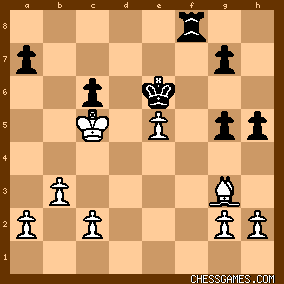
click for larger view32. c4?
"?"--(Tournament Book)
The last ditch effort 32. h4?! was about all that was left for Didier to try. After 32. c4? the position was:

click for larger viewMason now cleaned up with no delay. |
|
Jan-18-20
 | | KEG: Didier v.Mason--Post IV
32... h4
Time to clean up on the King side with his Majesty off in never-never land. 33. Be1 Rf1
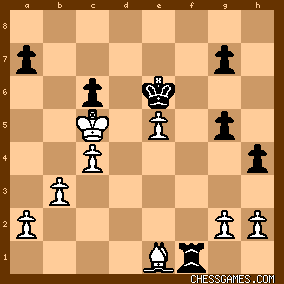
click for larger view34.Bc3
Everything loses here for White.
34... Rf2
Ouch!
35. Kxc6
Going for broke on the Queens-side, but its hopeless. 35... Rxg2
36. Kb7 Rxh2

click for larger viewDidier now decided to play his one card.
37. c5 Rc2
So much for that idea!
37...h3 would also have won quickly, but the text emphasizes the hopelessness of Didier's forces. 
click for larger viewResigns
And not a moment too soon. |
|
|
|
|





